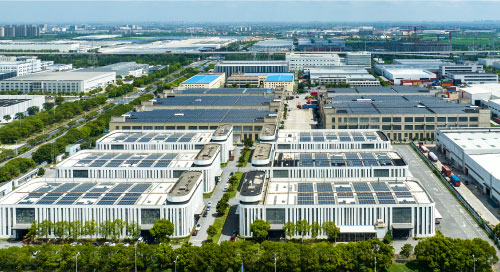Fill form to unlock content
Error - something went wrong!
Your content is just a step away. Please submit below.
Thank you!
Smart Park Solutions Power Sustainable Development

We all want to help reduce carbon emissions and support sustainability goals. But while individual responsibility is important, large-scale industrial campuses are a major contributor to global CO2 emissions.
This is why many countries make smart business parks a key component of their carbon-reduction strategy. Smart parks are industrial, technological, commercial, or mixed-use venues that leverage AI and IoT technologies to improve energy efficiency and reduce waste.
These low-carbon parks are crucial. But unfortunately, they can be difficult to implement and manage. “Smart parks integrate a tremendous variety of energy- and resource-consuming equipment, such as power and water, heating and air conditioning, electrical systems, and more,” says Dr. Yang Yang, Chief Scientist at Terminus Group, a provider of smart city solutions. “It’s very challenging to collect, coordinate, and analyze all of that information—and many venue managers lack the technical and operational abilities needed to run a low-carbon park.”
The good news for cities and governments is that AIoT specialists have started to offer comprehensive smart park solutions. These integrated platforms provide the hardware and software tools needed to streamline the construction of smart business parks and upgrade existing venues and campuses to be more energy-efficient.
Smart Parks in Action: A Chongqing Case Study
Terminus Group’s deployment at the Chongqing branch of China’s Western Science City project is a case in point.
Western Science City is a government initiative aimed at creating a technology hub around the cities of Chongqing and Chengdu in China’s western Sichuan Province. The initiative is intended as an engine of innovation and entrepreneurship that will house major high-tech infrastructure such as the Chongqing University Laboratory for Ultrafast Transient Facility and the Chongqing Center of the China Natural Population Resource Biobank.
The site has tremendous scientific and economic potential—but needs to overcome the challenges of high energy consumption and fossil fuel use. For this reason, the managers of Western Science City-Chongqing partnered with Terminus Group to reduce carbon emissions and use resources more efficiently.
Working with Terminus Group, venue managers implemented an intelligent solar power storage and charging infrastructure. The solution uses an edge-powered digital twinning platform to monitor storage capacity and charging loads in real time and adjust the behavior of distributed photovoltaics (DPVs) and charging equipment accordingly. This enables Western Science City-Chongqing to optimize its energy storage, charging, and discharging strategies.
The implementation has been a success: accelerating the adoption of clean energy at the park, reducing utility costs, and cutting carbon emissions while at the same time supporting distributed sustainable power generation, electric vehicle use, and demand management.
AIoT and Edge Hardware Improve Planning and Management
AIoT smart park platforms like the one developed by Terminus Group are so powerful because of their ability to collect, aggregate, and analyze huge amounts of environmental information—and then translate all of that into smarter planning, design, and management.
On the level of planning and design, a smart park platform can be used to simulate facility performance and conduct comprehensive energy-efficiency audits. This allows venue managers to gain insights into how they’re using resources sitewide and take action if problems are detected. It also helps them compare and select optimal solutions before construction begins, to ensure that future development will be as sustainable as possible.
In terms of operations and management, smart park platforms offer several ways to save power and reduce emissions:
- Building automation tools centralize management and control of mechanical and electrical infrastructure for load optimization.
- Smart solar power systems with integrated storage and charging capabilities foster development of clean-energy infrastructure.
- IoT smart metering and environmental monitoring at the edge provide real-time information on resource consumption and environmental conditions.
- AI systems generate peak consumption reports that can be used to create better energy management plans.
- AI systems monitor the IoT devices for signs of abnormal use and alert management if a problem is detected, allowing both on-site and remote-facilities managers to quickly intervene.
- Intelligent robotics systems for food delivery, logistics, and security can be integrated to further reduce sitewide carbon emissions and improve the day-to-day experience of workers and visitors.
Integrated control and real-time analysis require significant processing power at the #edge—and sophisticated #AI behind the scenes. @Terminus_group via @insightdottech
Integrated control and real-time analysis require significant processing power at the edge—and sophisticated AI behind the scenes. For this reason, the technology partnership between Terminus Group and Intel is crucial in bringing this solution to market. “Our edge gateways, controllers, and all-in-one systems all use Intel® processors, which offer an extremely stable, reliable, and high-performance platform for computing at the edge,” says Dr. Yang Yang. “In addition, Intel® Smart Edge Open gave us an edge-native platform that helped speed the development and deployment of our applications, and the Intel® OpenVINO™ toolkit helps optimize the AI inferencing performance of our platform.”
The Outlook for Smart Park Solutions
Smart park platforms offer a clear path to construction and operation of low-carbon venues—and thus will be highly attractive to city planners, systems integrators, and campus managers.
In addition, the AI analytics capabilities of these platforms can make retrofits of existing industrial parks and technology campuses far more cost-effective. “Our solution can be used to create detailed energy conservation retrofit plans and even design cost-saving retrofit schematics,” says Dr. Yang Yang. “For example, a site upgrade might begin with building-integrated photovoltaics (BIPVs); the carbon emission reductions provided by BIPVs can then be converted into carbon credits or green certificates and traded on the market to offset the cost of the initial stages of construction.”
The world urgently needs to meet challenging carbon emissions targets in the coming years. Smart parks and AIoT platforms that support them help put these goals within reach—and promise a greener, more sustainable future for us all.
Edited by Georganne Benesch, Editorial Director for insight.tech.